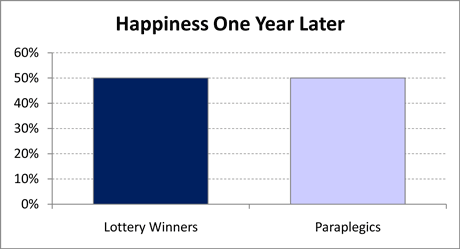Why do we sit on failing investments?
Two years ago (Psychology of Investment), I discussed the psychology of our investment decisions and why we have a psychological predisposition to buy when the markets are high and sell when markets are low.
At the time, I felt that my article had addressed the basics of structuring an investment portfolio to avoid the common pitfalls whilst highlighting the emotional attachment that we develop with our own investments and our propensity to avoid loss.
I have thought about this a lot since then as I have always felt that not only are we disadvantaged by our emotional attachment and natural aversion to loss, but we are disadvantaged in our ability to initially identify which investments are the proverbial dogs in our portfolios.
We are far more likely to invest new money into a poor performing investment we already hold than if we didn’t already hold it.
Why are we happy?
I recently watched a seminar by Harvard psychologist Dan Gilbert that challenged the idea that we’ll be miserable if we don’t get what we want.
Our ability to imagine possible outcomes for the decisions we make is a key reason for the progression of our species as it allows us to understand the ramifications of our decisions and choose what should make us feel happier. As a result, our decisions are often tainted with ambition as we start to imagine how much happier we would be if we achieved X instead of the most likely outcome Y.
If you reach for the stars at the very least, you will hit the rooftops
Synthetic Happiness
What I found most intriguing was Gilbert’s argument that we have also developed a “synthetic happiness”, a psychological immune system to protect us from constant disappointment. Allowing us to “change our view of the world, so that we can feel better about the world in which we find ourselves”.
We tend to view these individuals as deluding themselves, that they cannot be as happy as those who have achieved natural happiness by achieving their goals, but research has shown that over time, those that have fallen on hard times become just as happy in their lives as those who have realised their ambitions.

His seminar demonstrated numerous examples of individuals who have fallen on hard times, despite now being worse off, feel that they are happy now.
“I’m happier than I would have been with the Beatles”
Pete Best (quote 1994), the Beatles original drummer
And this has been demonstrated again and again, across countless psychological experiments. Simply put, our brains are hardwired to make us feel better about the world in which we find ourselves. How often have you heard the expressions “make the best of a bad lot” or “happiness is a state of mind” or something similar? It’s programmed into us.
Synthetic Happiness in our Investment Strategies
Having spent some 14 years working in financial services including some time working as a research analyst, I found myself drawing parallels. The analogy of Synthetic Happiness goes some way to explaining why we find it so difficult to switch out of poor performing investments. How can we expect to address our emotional attachments and instinct to avoid loss with our investments when we are disadvantaged in our ability to assess whether the investment is performing poorly in the first place?
 Overcoming the Happiness Trap
Overcoming the Happiness Trap
Whether you are a DIY or professional investor, you will be affected by these irrational investment choices and helps to explain why so many of us sit tight when investments turn sour. Professional managers have a whole range of sophisticated indicators to try and overcome our behavioural disadvantages. As DIY investors we need to recognise our shortcomings and structure the way in which we assess our investments to overcome our natural “immune system”.
So what can we do to stop ourselves falling into the Happiness Trap?
As a DIY investor, it really helps if you can write down the reasons as to why you are investing in a product before you invest – This is a significant crutch when we come to re-assess our investments. Investors who have used a financial planner will have received a Statement of Advice (SoA), listing why the recommendations were made in the first place. I regularly see clients pulling out old SoAs to refer to when we meet. DIY investors don’t have this luxury, so it makes sense to write things down as a sanity check when reviewing your portfolio.
The grass will always look greener – The freedom to choose can also impair judgement as we can also imagine how much happier we would be in another investment. We often place too much emphasis on past performance and jump ship to a riskier/inappropriate investment when our existing investment has achieved everything we expected.
Just being aware that we have a tendency to favour investments we already hold will influence your decision making – This then allows you to question whether you are making a decision based on real or just perceived results (natural or synthetic happiness?).
Perform a risk profile and stick to the appropriate asset class make up – Diversifying in this way helps ensure that your portfolio doesn’t roller coaster up and down, allowing to sleep at night and avoids you taking undue risk in trying to make up for your losses. We automatically perform a risk profile for all our clients and provide an asset allocation specific to their needs. The common mistake we see is investors often consider a portfolio of Australian Equities spread across a number of sectors to be diversified, when in reality these sectors are generally heavily reliant on one another. Sectors such as emerging markets, fixed interest, property, international western economies and our own local market all offer different levels of risk and returns at different times in the cycle.
I generally consider an asset allocation as a track to run on with your portfolio. It’s a real sanity check when you find yourself naturally deviating towards opportunity and allows you to visualise the relative risk your taking by changing the makeup of your portfolio.
Our online risk profiler can help you decide where you lie and offers suggestions on a suitable asset allocation. www.fundsfocus.com.au/managed-funds/risk-profiling.html
Ask yourself, if you were to invest new money today would you be invest into this fund/product/share versus its peers? My proviso on this rule is the phrase “relative to its peers” since an investment fund may be performing well relative to others within its asset class but the overall asset class may just be running through a natural downturn. Jumping ship from one sector to another injects undue risk into your portfolio, so it is important to consider this rule alongside your planned asset allocation.
If the answer is “no I wouldn’t use this investment if I were to invest in this sector”, that’s generally a warning sign to look at moving on.
Is it worth taking the risk? In essence, much of our investment decisions should boil down to how much return are we expecting to receive in excess of cash in the bank. Consider the long term returns you expect to achieve and by how much do you expect this to beat cash. Is the risk of losing money worth the risks we are taking?
Take emotion out of the equation – If an investment no longer meets the criteria you have established, get out and move on. This is one of the reasons we like to combine products like Man Investments AHL Diversified Fund and AHL Gold as a diversifier, this are computerised trend seeking strategies that have no emotion in the decisions made.
Take Advice – Everyone can benefit from getting a little advice along the way. After all, it’s your money, so you don’t have to follow it if you choose not to, but considering advisers spend all day every day analysing these things, there’s no harm in getting another opinion.

Comment: